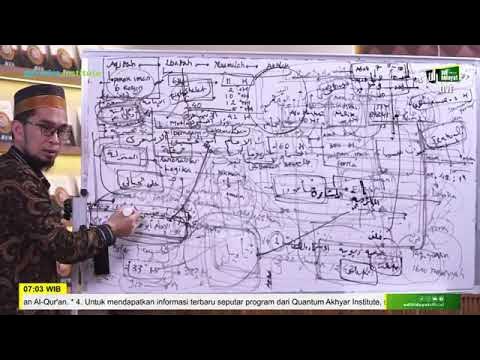Hukum Memasang Kalung Lonceng pada Hewan Peliharaan - Buya Yahya Menjawab
Summary
TLDRThe video discusses the Islamic perspective on placing bell collars on animals, referencing Imam Ghazali’s teachings. The practice is generally considered **makruh** (discouraged) unless there is a legitimate purpose, such as for identifying or protecting livestock. The bell serves a functional role, like alerting the owner or marking animals for security. The action is not deemed **haram** (forbidden) if it has a beneficial use, but without a purpose, it remains discouraged. The discussion highlights the importance of intention and practical need in Islamic jurisprudence regarding animal care.
Takeaways
- 😀 The question asked is about the permissibility of putting a bell or collar on pets in Islam.
- 😀 There are differing opinions, with some saying it's haram and others saying it's halal.
- 😀 Imam Ghazali's book addresses this issue and provides insights on the practice.
- 😀 In general, scholars classify the act of hanging a bell or collar on an animal as *makruh* (disliked), as it serves no clear beneficial purpose.
- 😀 If the collar or bell has a useful purpose, such as preventing theft or identifying livestock, it becomes permissible.
- 😀 For example, a bell on livestock may be used to prevent them from being stolen or lost, which makes it acceptable.
- 😀 The practice does not reach the level of haram (forbidden) if there is a valid reason for its use.
- 😀 If there is no useful purpose for the collar or bell, it remains *makruh* (discouraged).
- 😀 The story of the Prophet cutting off a collar relates to marking animals for slaughter or sacrifice, and this practice is acceptable in Islam.
- 😀 The key point is that if a collar or bell is used for a specific purpose (such as security or marking animals for sacrifice), it is not considered haram.
Q & A
What is the general ruling on attaching a bell or collar to an animal according to Islamic scholars?
-The general ruling is that it is considered 'makruh,' which means it is disliked but not forbidden. However, if there is a specific purpose or necessity, such as for safety or identification, the act can become permissible.
Who is referenced in the script as discussing the issue of attaching bells or collars to animals?
-The script refers to Imam Ghazali, specifically his views in his authoritative texts, where he addresses the issue of attaching a bell or collar to animals.
What does 'makruh' mean in the context of this ruling?
-'Makruh' refers to actions that are disliked in Islam, but not strictly prohibited. It suggests that while the act is not ideal, it is not punishable unless it involves a valid necessity.
Why is attaching a bell or collar to an animal considered 'makruh'?
-It is considered 'makruh' because there is generally no benefit to it. The collar or bell is seen as unnecessary unless there is a specific reason or benefit, such as ensuring the safety or identification of the animal.
Can attaching a bell or collar to an animal become permissible in certain circumstances?
-Yes, if there is a legitimate reason, such as for the safety of the animal (e.g., identifying livestock or preventing theft), the act can no longer be considered 'makruh' and can be permissible.
What is an example where attaching a bell to an animal would not be considered 'makruh'?
-An example would be when a bell is attached to a livestock animal like a cow or goat to help the owner track the animal’s movements and prevent it from being stolen or lost.
Does the ruling on bells and collars change depending on their use?
-Yes, the ruling changes based on the purpose. If the bell or collar serves a functional or protective purpose for the animal, it becomes permissible, whereas if it serves no purpose, it remains 'makruh.'
What is the reasoning behind the Islamic scholars' allowance for the use of bells for marking animals?
-The allowance is based on practical needs. For instance, a bell might be used to identify an animal being taken for sacrifice or during specific rituals like Hajj, where marking or identifying an animal is necessary.
What did the speaker say about the story of the Prophet regarding animal collars?
-The speaker referenced a story where the Prophet allowed an animal to be marked with a collar when it was being prepared for slaughter, as part of the ritual sacrifice, and emphasized that there was no issue with such marking.
How does the speaker distinguish between acts that are 'makruh' and those that are haram?
-The speaker notes that attaching a bell to an animal does not reach the level of being 'haram' (forbidden). It remains 'makruh' unless it serves a valid and beneficial purpose, in which case it becomes permissible.
Outlines

此内容仅限付费用户访问。 请升级后访问。
立即升级Mindmap

此内容仅限付费用户访问。 请升级后访问。
立即升级Keywords

此内容仅限付费用户访问。 请升级后访问。
立即升级Highlights

此内容仅限付费用户访问。 请升级后访问。
立即升级Transcripts

此内容仅限付费用户访问。 请升级后访问。
立即升级浏览更多相关视频

KULTUM RAMADHAN #Day 16 Jangan Umbar Auratmu bersama Ustzh. Siti Aisyah, S.Pd.I

EPS 49 Al-Ghazali: Figur Mujtahid Mutlak dalam Tasawuf

PEMIKIRAN EKONOMI ABU HANIFA DALAM PREPEKTIF PHILOSOPHY OF ECONOMIC SYSTEM CAPITALIST

BUKBER BARENG PACAR | Ustadz Muhammad Nuzul Dzikri hafizhahullah

Sunnii: Al-Asy'arii, Al-Maaturiidii, dan Ibnu Taimiyyah - Ustadz Dr. (HC) Adi Hidayat, Lc., M.A.

1. Penetapan Kepemilikan : a. Larangan monopoli b. Pengharaman riba
5.0 / 5 (0 votes)
